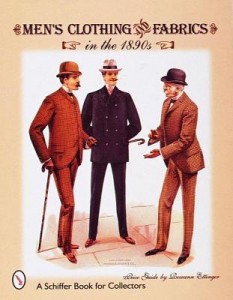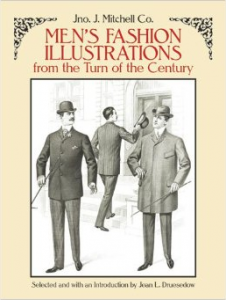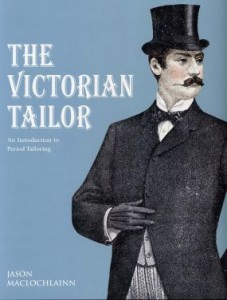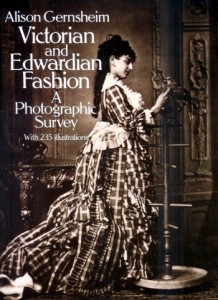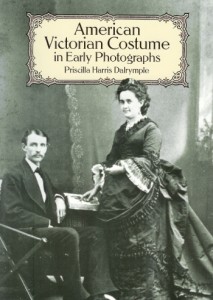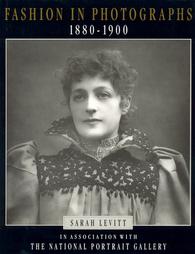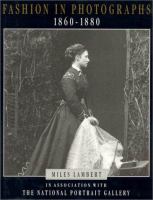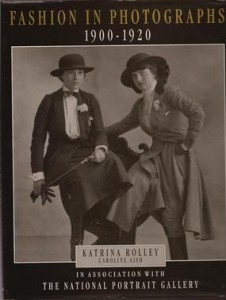Hill, Daniel Delis. American menswear : from the Civil War to the twenty-first century. Lubbock, Texas: Texas Tech University Press, 2011.
(see: General Menswear Survey Books)National Portrait Gallery Series:
Lambert, Miles, and National Portrait Gallery. Fashion in Photographs, 1860-1880. London: Batsford, 1991.
Levitt, Sarah, and National Portrait Gallery (Great Britain). Fashion in Photographs, 1880-1900. London: B.T. Batsford, 1991.
Rolley, Katrina, Aish, Caroline, and National Portrait Gallery. Fashion in photographs, 1900-1920. London: Batsford, 1991.
This series is a valuable resource from England’s National Portrait Gallery, with quality photographs of mostly royal and upper-class men and women. Divided into 5-year periods, photographs are further divided into “Male,” “Female,” and “Group” categories, and also include many fine images of children. However, the accompanying text is better at captioning the individual photographs on their own rather than putting any particular fashion into context or presenting a clear overview of what was worn when. Of course most are formal posed portraits, but some attempt is made at more informal settings, and include images of sporting costume, clerical dress, fancy dress, and some servants.
1840’s – 1880’s
Dalrymple, Priscilla Harris. American Victorian Costume in Early Photographs. New York: Dover, 1991. – This Dover publication provides fairly good quality reproductions of American studio portraits, from a personal collection by the author. Each decade is prefaced by a brief over-view of the fashions of the period, with some quotations from contemporary fashion magazines. They mention new fashion trends but not any overview of when a person was to wear what, or how many different types of garments one might have in one’s wardrobe. Captions tend to explain the obvious instead of giving a more useful context, and dates are given only occasionally. All photographs are posted studio portraits, and most men are posed sitting down. All in all, this is a useful resource, particularly for American middle-class fashions.
Davis, R. I. Men’s Garments, 1830-1900: a Guide to Pattern Cutting and Tailoring. Rev., 2nd ed. Studio City, CA: Players Press, 1994.
Early Victorian Men. Fort Bragg, CA: R.L. Shep, 2001.
Lambert, Anthony J. Victorian and Edwardian Country-House Life. Holmes & Meier Publishers, Inc., 1981.
Gernsheim, Alison. Victorian & Edwardian fashion : a photographic survey. New York: Dover Publications, 1981. – A good introduction survey to Victorian photographs, with some interesting characters portrayed, though the primary focus is women’s costumes. Unfortunately many of the photographs are dark and poorly reproduced, which is particularly problematic when trying to ascertain details of men’s tailoring. First published in (and not updated since) 1963, the commentary has a rather dated – though informative in itself – perspective. The author was not a fashion historian, but rather a photo-historian, and along with her husband, Helmut, collected and maintained one of the world’s seminal collections of early photography.
Maclochlainn, Jason. The Victorian Tailor : an Introduction to Period Tailoring. New York: St. Martin’s Griffin, 2011. – This book is geared for the tailor, with patterns, measurements, and instructions on period tailoring. However, it does offer some valuable primary source illustrations for a period where it is often difficult to find information.
1890’s – 1910’s
Druesedow, Jean L, and Jno. J. Mitchell Co. Men’s fashion illustrations from the turn of the century. New York: Dover, 1990. – An excellent, excellent resource. Fashion drawings are large and very clearly reproduced. They span the entire decade, in chronological order, with the month of the year clearly noted. Fashions for every occasion are represented here, from business dress to formalwear, and includes sportswear and coachman and butler livery. The only drawback is that there are no captions to further explain the situations depicted. Granted, the background illustrations provide as much context as possible, but the novice might not notice, for instance, that the man wearing a tuxedo is emphatically not in the presence of ladies.
Ettinger, Roseann. Men’s Clothing & Fabrics in the 1890s : Price Guide. Atglen, PA: Schiffer Pub., 1998. – This book is very useful, despite its somewhat misleading title. It does show prices for some of its suits, but its usefulness comes with both its extraordinary range of fashion illustrations and photographs of original swatches. The illustrations depict men in a wide range of situations, from day to night and summer to winter, and include everything from dressing gowns and overcoats to train conductor uniforms. The downside is that there is no accompanying text to these excellent pictures, and therefore is no explanation for when these garments should be worn, which is of course the primary guidance for menswear. Another bone to pick is that while the title implies that these fashions represent the whole decade, they are in fact primarily from 1897-99, and even the bibliography only lists one source from as early as 1895.
